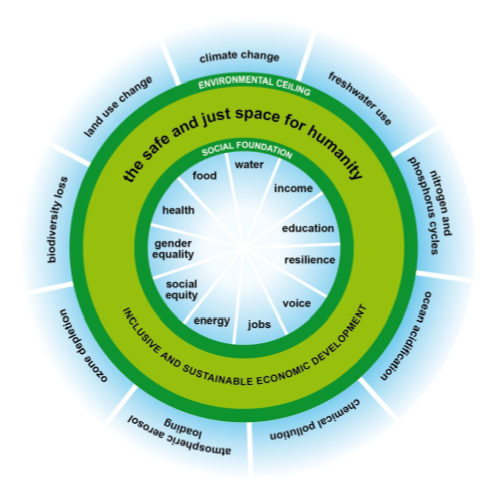It has inspired and been referenced by a diverse selection of scholars, protest movements and international organizations – but what exactly is the doughnut economy? And what can it tell us about twenty-first century work and development?
Doughnut economics is based on the work of Kate Raworth. She first published the doughnut in a 2012 report for Oxfam. Following widespread international interest, Raworth followed up the Oxfam discussion paper with a book in 2017. Doughnut economics: seven ways to think like a 21st century economist explored the economic thinking necessary to bring humanity into the doughnut.
Why a doughnut?
The concept of the doughnut developed by Raworth shows how “a safe and just space for humanity” exists within two thresholds. On the outside of the doughnut, the safe space is bordered by an environmental ceiling, outside which humanity will breach critical natural thresholds. On the inside of the doughnut, the safe space is bordered by a social foundation, beneath which humanity experiences critical human deprivations.

Raworth’s doughnut illustrates how humanity is breaching the safe space of the doughnut in both directions – with problematic human and environmental results.
Breaching the safe space of the doughnut
In her work, Raworth gives numerous examples of how humanity is breaching the safe space of the doughnut.
She also shows how this needn’t be the case. For example, 57 percent of global income is in the hands of just 10 percent of the people. The poorest 20 percent of people hold less than 2 percent. Yet ending income poverty for the 20 percent of the global population who live on less than $1.25 per day would require just 0.2 percent of global income.
Similarly, providing the additional calories needed by the 13 percent of the world’s population who face hunger would require just one percent of the current global food supply. And 50 percent of the world’s carbon emissions are generated by just 11 percent of people.
These statistics, says Raworth, show that eradicating poverty or hunger do not need to put the planetary boundaries under stress.
The implications of the doughnut
Raworth argues that human rights advocates have long highlighted the imperative of ensuring every person’s claim to life’s essentials. Ecological economists have emphasised the need to situate the economy within environmental limits. Raworth’s work put these two imperatives together for the first time – and showed that they could be achieved simultaneously.
She says, “Achieving sustainable development means ensuring that all people have the resources needed – such as food, water, healthcare and energy – to fulfil their human rights. It means ensuring that humanity’s use of natural resources does not stress critical Earth-system processes – by causing climate change or biodiversity loss, for example – to the point that Earth is pushed out of the stable state, known as the Holocene, which has been so beneficial to humankind over the last 10,000 years.”
The actions we need to take
The concept of the doughnut is useful because it shows that social justice and environmental good practice are not contradictory goals, but part of the same goal: keeping humanity within the safe and just space of the doughnut.
Raworth proposes the framework as both an integrated vision for sustainable development and also as a way to refocus economic priorities. The economy’s overarching goal should be to bring humanity into the safe space of the doughnut, she says. To this end, measuring the success of an economy in GDP is no longer a valid metric. Policy makers should be more accountable within the metrics of the doughnut – such as tonnes of carbon emitted or number of people facing hunger. These would be more valid ways to measure the success of an economy.
You can read more about this topic in Raworth’s book and on the Doughnut Economics Action Lab website, which includes a link to download the first chapter of Doughnut economics: seven ways to think like a 21st century economist.
How can we move into the doughnut?
- Find out how the paper industry is changing the way it works to achieve sustainability goals.
- If you’d like inspiration about the changes your own organisation can make, see how we’re planning to make 2022 a more sustainable year here.
- Plus, we ask: After COP-26 is the goal of limiting global warming to 1.5˚C still alive?